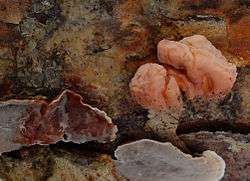Stereum sanguinolentum
| Stereum sanguinolentum | |
|---|---|
 | |
| Scientific classification | |
| Kingdom: | Fungi |
| Division: | Basidiomycota |
| Order: | Russulales |
| Family: | Stereaceae |
| Genus: | Stereum |
| Species: | S. sanguinolentum |
| Binomial name | |
| Stereum sanguinolentum (Alb. & Schwein.) Fr. (1838) | |
| Synonyms[1] | |
|
Thelephora sanguinolenta Alb. & Schwein. (1805) | |
Stereum sanguinolentum is a species of fungus in the Stereaceae family. A plant pathogen, it causes red heart rot, a red discoloration on conifers, particularly spruces or Douglas-firs. Fruit bodies are produced on dead wood, or sometimes on dead branches of living trees. They are a thin leathery crust of the wood surface. Fresh fruit bodies will bleed a red-colored juice if injured, reflected in the common names bleeding Stereum or the bleeding conifer parchment. It can be the host of the parasitic jelly fungus Tremella encephala.[2]
Taxonomy
The species was first described scientifically by Albertini and Schweinitz in 1805 as Thelephora sanguinolenta.[3] Other genera to which it has been transferred throughout its taxonomical history include Phlebomorpha, Auricularia, Merulius, and Haematostereum.[1] The fungus is commonly known as the "bleeding Stereum" or the "bleeding conifer parchment".[4]
Description
The fruit body of Stereum sanguinolentum manifests itself as a thin (typically less than 1 mm thick) leathery crust on the surface of the host wood. Often, the upper edge is curled to form a narrow shelf (usually less than 10 mm thick). When present, these shelves are can be fused to or overlap neighboring shelves. The surface of the fruit body consists of a layer of fine felt-like hairs, sometimes pressed flat against the surface. The color ranges from beige to buff to dark brown in mature specimens; the margin are lighter-colored. Fresh fruit bodies that are injured exude a red juice, or will bruise a red color if touched. The fruit bodies dry to a greyish-brown color. The spores are ellipsoid to cylindrical, amyloid, and typically measure 7–10 by 3–4.5 µm.[5]
Stereum sanguinolentum can be parasitized by the jelly fungus Tremella encephala.[2]
Habitat, distribution, and ecology

The fungus causes a brown heart rot, resulting in wood that is a light brown to red-brown color, and dry, with a stringy texture. A cross-section of infected wood reveals a circular infection around the center of the log.[6] It enter opens wounds of plants caused by mechanical damage or by grazing wildlife. Fragments of mycelia can be spread by wood wasps (genus Sirex).[4] The rot spreads up to 40 cm (16 in) per year.[7] It has also been recorded on balsam fir, Douglas fir, and western hemlock.[8] The fungus is widespread in distribution, and has been recorded from North America, Europe, east Africa, New Zealand,[7] and Australia.[9]
References
- 1 2 "Stereum sanguinolentum (Alb. & Schwein.) Fr. 1838". International Mycological Association. Retrieved 2011-07-07.
- 1 2 Zugmaier W, Bauer R, Oberwinkler F (1994). "Mycoparasitism of Some Tremella Species". Mycologia. 86 (1): 49–56. doi:10.2307/3760718. JSTOR 3760718.
- ↑ Albertini JB, von Schweinitz LD (1805). Conspectus Fungorum in Lusatiae superioris (in Latin). Leipzig, Germany: Sumtibus Kummerianis. p. 274.
- 1 2 Schmidt O. (2006). Wood and Tree Fungi: Biology, Damage, Protection, and Use. Berlin, Germany: Springer. p. 195. ISBN 3-540-32138-1.
- ↑ Eriksson J, Hjortstam K, Ryvarden L (1984). The Corticiaceae of North Europe. Vol. 7, Schizopora-Suillosporium. 7. Oslo, Norway: Fungiflora. p. 1431.
- ↑ McKnight TE, Mullins EJ (1981). Canadian Woods: Their Properties and Uses (3rd ed.). Toronto, Canada: University of Toronto Press. p. 190. ISBN 978-0-8020-2430-5.
- 1 2 Smith IA. (1988). European handbook of plant diseases. Wiley-Blackwell. p. 512. ISBN 978-0-632-01222-0.
- ↑ Tainter FH, Baker FA (1996). Principles of Forest Pathology. Chichester: Wiley. p. 764. ISBN 978-0-471-12952-3.
- ↑ May TW, Milne J, Shingles S. (2003). Fungi of Australia: Catalogue and bibliography of Australian fungi. Basidiomycota p.p. & Myxomycota p.p. Csiro Publishing. p. 307. ISBN 978-0-643-06907-7.
External links
| Wikimedia Commons has media related to Stereum sanguinolentum. |